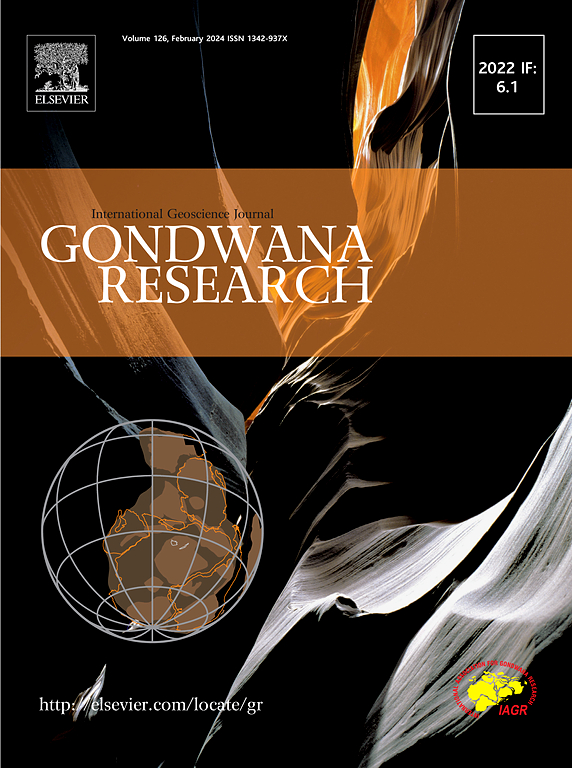从岩石化学和多同位素(Sr-Nd-B-Hf)系统学的角度解读哲罗纪沉积物岩浆爆发的成岩来源、成分多样性和构造-岩浆情景:石油化学和多同位素(锶-钕-硼-铪)系统学的故事
IF 7.2
1区 地球科学
Q1 GEOSCIENCES, MULTIDISCIPLINARY
引用次数: 0
摘要
地球的大陆地壳主要由花岗岩组成,然而纯沉积物衍生的过铝花岗岩(PGs)的成因仍存在争议。本研究以巴基斯坦喜马拉雅山西北部的奥陶纪 Mansehra 花岗岩群(约 476-483 Ma)为例,研究了 S 型花岗岩,并将其与来自滇苍山-艾劳山(中国)、唐古拉-达姆松(西藏)和卡拉梅斯(土耳其)的全球同类花岗岩进行了比较。地球化学和同位素数据,包括可变的锆石εHf(t)值(-37.7 至 + 12.6)、富集的 Sr 同位素比((87Sr/86Sr)i:0.5678-0.7444)、负的 εNd(t)值(-13.4 至 - 2.9)和较窄的 δ11B 范围(-15.4 ‰至- 9.5 ‰),表明PGs是在地壳下-上部浅层低压条件下,通过部分熔融异质、成熟的辉长岩源而形成的,地幔输入极少。不同的 Hf 同位素行为反映了不同的变质原岩的不平衡熔融。地球化学模型显示,流体流动熔融是主要的熔融过程,但唐古拉花岗岩除外,它们表现出流体缺失熔融的特征。从构造上看,曼塞赫拉花岗岩被解释为冈瓦纳北部下方原泰西期大洋俯冲的产物,是通过后弧盆地沉积物的非平衡熔融形成的。板岩断裂很可能引发了流体层上升流,从而增强了热通量,并推动了无氧运动和PG的生成。虽然全球 PGs 代表了不同的地球动力演化背景,但它们主要显示了重要的构造事件,而不是对地壳增长的直接贡献。曼塞赫拉 PGs 以及类似的花岗岩记录了与碰撞构造有关的大规模消长,为了解地球地球动力演化提供了重要信息。本文章由计算机程序翻译,如有差异,请以英文原文为准。

Retrieving petrogenetic source, compositional diversity and tectono-magmatic scenario of Tethyan sediment-derived magmatic flare-up: A tale from petrochemical and multi-isotopic (Sr–Nd–B–Hf) systematics
The Earth’s continental crust is predominantly composed of granitic rocks, yet the genesis of pure sediment-derived peraluminous granites (PGs) remains debated. This study investigates the Ordovician Mansehra granitic suite (ca. 476–483 Ma) from the northwestern Himalayas of Pakistan as an example of S-type granites, comparing them with global counterparts from Diancangshan-Ailaoshan (China), Tanggula-Damxung (Tibet), and Karamese (Turkey). Geochemical and isotopic data, including variable zircon εHf(t) values (−37.7 to + 12.6), enriched Sr isotope ratios ((87Sr/86Sr)i: 0.5678–0.7444), negative εNd(t) values (−13.4 to − 2.9), and a narrow δ11B range (−15.4 ‰ to − 9.5 ‰), indicate that PGs formed through partial melting of heterogeneous, mature pelitic sources under shallow, low-pressure conditions in the lower–upper crust, with minimal mantle input. Heterogeneous Hf isotopic behavior reflects the disequilibrium melting of variable metasedimentary protoliths. Geochemical modeling highlights fluid-flux melting as the dominant process, except for the Tanggula granites, which exhibit characteristics of fluid-absent melting. Tectonically, the Mansehra PGs are interpreted as products of Proto-Tethyan oceanic subduction beneath northern Gondwana, formed through the disequilibrium melting of exhumed back-arc basin sediments. Slab break-off likely triggered asthenospheric upwelling, enhancing heat flux and driving anatexis and PG production. While global PGs represent different geodynamic evolutionary contexts, they predominantly display significant tectonic events rather than direct contributions to crustal growth. The Mansehra PGs, along with similar granites, record large-scale anatexis linked to collisional tectonics, providing critical insights into Earth’s geodynamic evolution.
求助全文
通过发布文献求助,成功后即可免费获取论文全文。
去求助
来源期刊

Gondwana Research
地学-地球科学综合
CiteScore
12.90
自引率
6.60%
发文量
298
审稿时长
65 days
期刊介绍:
Gondwana Research (GR) is an International Journal aimed to promote high quality research publications on all topics related to solid Earth, particularly with reference to the origin and evolution of continents, continental assemblies and their resources. GR is an "all earth science" journal with no restrictions on geological time, terrane or theme and covers a wide spectrum of topics in geosciences such as geology, geomorphology, palaeontology, structure, petrology, geochemistry, stable isotopes, geochronology, economic geology, exploration geology, engineering geology, geophysics, and environmental geology among other themes, and provides an appropriate forum to integrate studies from different disciplines and different terrains. In addition to regular articles and thematic issues, the journal invites high profile state-of-the-art reviews on thrust area topics for its column, ''GR FOCUS''. Focus articles include short biographies and photographs of the authors. Short articles (within ten printed pages) for rapid publication reporting important discoveries or innovative models of global interest will be considered under the category ''GR LETTERS''.
 求助内容:
求助内容: 应助结果提醒方式:
应助结果提醒方式:


